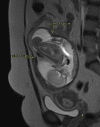Robert's uterus (asymmetric septate uterus): a rare congenital Müllerian duct anomaly
- PMID: 35523517
- PMCID: PMC9083431
- DOI: 10.1136/bcr-2021-244237
Robert's uterus (asymmetric septate uterus): a rare congenital Müllerian duct anomaly
Abstract
Müllerian anomalies such as Robert's uterus, which was first described by the French gynaecologist Dr Helene Robert in 1969, are rare clinical entities and have been reported in <3% of the female population. Robert's uterus is a rare phenomenon with a relative dearth of reported cases. Affected individuals may present with pelvic pain and dysmenorrhoea that intensifies near menses or acutely, with severe abdominal pain to the emergency department. They are also associated with adverse pregnancy outcomes, abnormal fetal presentation, preterm labour, recurrent pregnancy loss and infertility. Although ultrasound has a role in its initial assessment, MRI is the best modality to further delineate its anatomy. It is typically managed via laparotomy and total horn resection, endometrectomy of the blind cavity or abdominal metroplasty. The authors present the case of a 40-year-old woman at 19+3 weeks gestation with acute onset of left-sided abdominal pain. A transvaginal ultrasound and MRI of the pelvis confirmed a Robert's uterus with a viable pregnancy in the upper left horn. She developed a ruptured horn with significant haemoperitoneum. An emergency laparotomy was performed and a non-viable fetus was evident. Only a few cases of pregnancy in the blind hemicavity have been reported so far. This case also highlights the importance of considering this diagnosis in young females presenting with dysmenorrhoea and normal menstrual flow. It is imperative to render a prompt diagnosis, as minimally invasive procedures may be more effective if detected before the formation of adnexal endometriomas.
Keywords: obstetrics and gynaecology; pregnancy.
© BMJ Publishing Group Limited 2022. No commercial re-use. See rights and permissions. Published by BMJ.
Conflict of interest statement
Competing interests: None declared.
Figures


Similar articles
-
Successful pregnancy in the blind hemicavity of Robert's uterus: a rare case report and brief literature review.BMC Pregnancy Childbirth. 2023 Mar 28;23(1):211. doi: 10.1186/s12884-023-05541-5. BMC Pregnancy Childbirth. 2023. PMID: 36978042 Free PMC article. Review.
-
Ultrasound combined with hysteroscopy for optimum treatment of Robert's uterus: a case report and a review.BMC Womens Health. 2022 Aug 7;22(1):334. doi: 10.1186/s12905-022-01903-x. BMC Womens Health. 2022. PMID: 35934693 Free PMC article.
-
Misdiagnosed Roberts Uterus Leading to Surgical Misadventures.J Pediatr Adolesc Gynecol. 2017 Aug;30(4):508-510. doi: 10.1016/j.jpag.2017.01.005. Epub 2017 Jan 17. J Pediatr Adolesc Gynecol. 2017. PMID: 28108213
-
An Exceptional Case of Complete Septate Uterus With Unilateral Cervical Aplasia (Class U2bC3V0/ESHRE/ESGE Classification) and Isolated Mullerian Remnants: Combined Hysteroscopic and Laparoscopic Treatment.J Minim Invasive Gynecol. 2016 Jan;23(1):16-7. doi: 10.1016/j.jmig.2015.09.006. Epub 2015 Sep 21. J Minim Invasive Gynecol. 2016. PMID: 26391060
-
Challenges in the diagnosis and management of Robert's uterus: Systematic review and case presentation.J Clin Ultrasound. 2024 Jun;52(5):619-628. doi: 10.1002/jcu.23675. Epub 2024 Mar 28. J Clin Ultrasound. 2024. PMID: 38549367
Cited by
-
Treatment of septate uterus.Zhong Nan Da Xue Xue Bao Yi Xue Ban. 2022 Nov 28;47(11):1487-1494. doi: 10.11817/j.issn.1672-7347.2022.220501. Zhong Nan Da Xue Xue Bao Yi Xue Ban. 2022. PMID: 36481626 Free PMC article.
-
Diagnosis and treatment of Robert's uterus combined with transverse uterine septum: a case report and review of the literature.Front Med (Lausanne). 2024 Aug 2;11:1434957. doi: 10.3389/fmed.2024.1434957. eCollection 2024. Front Med (Lausanne). 2024. PMID: 39156687 Free PMC article.
References
-
- Muraoka A, Tsuda H, Kotani T, et al. . Severe hemoperitoneum during pregnancy with obstructed hemivagina and ipsilateral renal anomaly syndrome: a case report. J Reprod Med 2016;61:290–4. - PubMed
-
- Robert HG. Uterus cloisonne avec cavite borgne sans hematometrie. CR Soc Fr Gynecol 1969;39:767–765.
Publication types
MeSH terms
LinkOut - more resources
Full Text Sources
Medical
